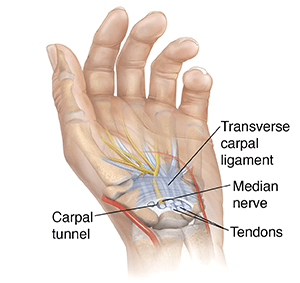Carpal Tunnel Syndrome
Patient Information Leaflet
Overview
The carpal tunnel is a narrow space inside the wrist. It is ringed by bone and the transverse carpal ligament. A major nerve called the median nerve runs from the forearm into the hand through the carpal tunnel along with other tendons. With carpal tunnel syndrome, the tendons or nearby tissues within the carpal tunnel may swell or thicken. Or the transverse carpal ligament may harden and shorten. This narrows the space in the carpal tunnel and puts pressure on the median nerve. This pressure leads to tingling and numbness of the hand and wrist. Overtime, the condition may interfere with simple daily tasks.
Causes
The causes of carpal tunnel syndrome are unclear, although, certain factors may increase the likelihood of having it. These include:
- Being female
- Being pregnant
- Being overweight
- Having diabetes or rheumatoid arthritis
Symptoms
Symptoms of carpal tunnel syndrome often come and go. At first, symptoms may occur mainly at night but can later progress to during the day. They may get worse with activities such as driving, reading, typing, or holding a phone. Symptoms can include:
- Tingling and numbness in the hand or wrist
- Sharp pain that shoots up the arm or down to the fingers
- Hand stiffness or cramping, especially in the morning
- Trouble making a fist
- Hand weakness and clumsiness
Treatment
If diagnosed and treated early, the symptoms of carpal tunnel syndrome can be relieved without surgery. If symptoms are mild, your doctor may recommend nonsurgical treatments before exploring more invasive ones as listed below.
Nonsurgical Treatment

- Bracing or splinting: Wearing a brace or splint at night will keep your wrist from bending and reduces pressure on the nerve in the carpal tunnel. It can also be worn during the day while performing activities that aggravate your symptoms.
- Nonsteroidal anti-inflammatory drugs (NSAIDs): You may take over-the-counter or prescription medicines such as ibuprofen and naproxen to help reduce swelling and relieve symptoms.
- Nerve gliding exercises: Specially instructed exercises may help the median nerve in some patients move more freely within the confined space of the carpal tunnel.
- Steroid injections: Anti-inflammatory agent, such as cortisone, can be injected into the carpal tunnel to temporary relieve painful symptoms or to diagnose the syndrome.

Surgical Treatment
In cases where nonsurgical treatments do not improve your condition, your doctor may recommend surgery. Carpal tunnel release surgery can be done under general anesthesia or local anesthesia. The outcomes of open surgery and endoscopic surgery are similar. There are benefits and potential risks associated with both techniques. Your surgeon will discuss with you to determine the best approach.
- Open carpal tunnel release: In open surgery, your surgeon makes a small incision in the palm of your hand to access and divide the transverse carpal ligament (the roof of the carpal tunnel). This increases the size of the tunnel and decreases pressure on the median nerve.
- After surgery, the ligament may gradually grow back together. Though, there will be more space in the carpal tunnel and less pressure on the median nerve.
- Endoscopic carpal tunnel release: In endoscopic surgery, your surgeon makes one or two smaller skin incisions, creating portals to insert a miniature camera (endoscope) to see inside your hand and wrist. Then the transverse carpal ligament will be divided like in open carpal tunnel release procedure.
Recovery
Immediately following surgery, you will be encouraged to elevate your hand above your heart and move your fingers to reduce swelling and prevent stiffness. Some pain, swelling, and stiffness after your procedure are expected. Minor soreness in your palm may last for several weeks to several months. Grip and pinch strength usually return by about 2 to 3 months after surgery, but progressive condition may take about 6-12 months to recover. You may have to wear a splint or brace for several weeks. However, you will be allowed to perform light activities soon after surgery as discussed with your doctor.
Complications
Although complications are possible with any surgery, your surgeon will take steps to minimize the risks. The most common complications of carpal tunnel release surgery include:
- Bleeding
- Infection
- Nerve aggravation or injury
Outcomes
For most patients, surgery will improve the symptoms of carpal tunnel syndrome. Recovery, however, may be gradual and complete recovery may take up to a year. If you have significant pain and weakness for more than 2 months, your doctor may refer you to a hand therapist who can help you maximize your recovery. Severe case of carpal tunnel or one that involves other conditions, such as arthritis or tendonitis, that cause pain or stiffness in your hand or wrist may slower your overall recovery.
Occasionally, carpal tunnel syndrome can recur, although this is rare. If this happens, you may need additional treatment or surgery.
References:
Krames Patient Education. (2020). Understanding carpal tunnel syndrome. Retrieved from https://dhch.kramesonline.com/3,S,82403
OrthoInfo. (2020). Diseases & conditions: Carpal tunnel syndrome. Retrieved from https://orthoinfo.aaos.org/en/diseases–conditions/carpal-tunnel-syndrome/


